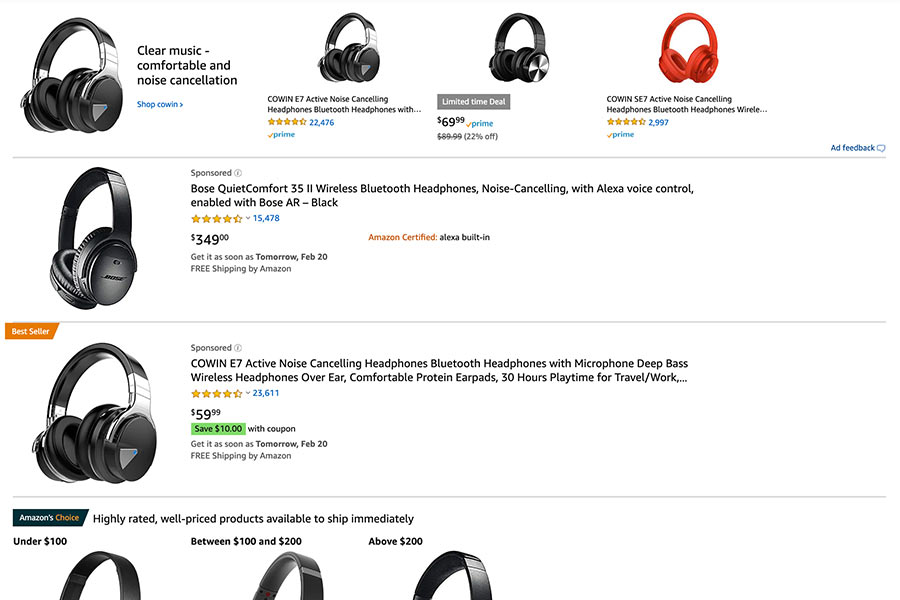The Amazon Inventory Liquidation Guide
How to Successfully Liquidate Excess Inventory on Amazon
Do you have end-of-life inventory that you want to liquidate? Is surplus stock from the holidays tying up capital you need to reinvest into your Amazon business?
While dealing with excess inventory can be a cumbersome undertaking, there are a variety of strategies you can implement to ensure that each decision you make relative to your inventory is calculated and precise.
To keep you from depleting your resources and spending a significant amount of money on long-term storage fees for items that are not converting, you should consider an inventory liquidation strategy.

1. Introduction
The Surplus Stock Scenario on Amazon
An effective, year-round inventory management strategy is crucial to the success of any e-commerce business.
While stocking out on top-selling products can lead lost sales and reduced customer satisfaction or loyalty, having excess inventory can be just as detrimental to your bottom line, as surplus stock ties up capital and prevents you from properly reinvesting into your online business.
Indeed, performing a regular analysis of your sales and inventory data is key to maintaining balanced inventory levels and making optimal forecasting and purchase decisions.
However, surplus stock is a common scenario all retail businesses face at one point or another. This is particularly common after the holiday season, either due to overestimating a product’s demand or from the flood of post-holiday returns.
In the 2019 holiday season, UPS estimated a record-breaking surge of returns — including 1.9 million returns on Jan. 2 alone, up 26% over last year.1
Whether you have unsold inventory from the holiday season, overbought from a supplier, or your sales velocity is stifled due to product detail page issues, there are several options available to help you clear out slow-moving or stagnant inventory before it begins to compromise your profits.
In this guide, we have compiled seven strategies to liquidate slow-moving or static inventory on Amazon.
While liquidating or reducing prices of excess inventory to drive sales is not ideal — regardless of your business size or perceived brand image — it is important to identify the issue and remove the inventory as quickly as possible, so not to further deplete your resources and stifle your growth potential.
Inventory management is one of the greatest challenges for any seller or retailer, and having a comprehensive understanding of which products to replenish — and which items might be at the end of their life cycle — can have a tremendous impact on your Amazon business’s overall success.

2. Top Causes of Overstock
What Is Excess Inventory?
To appropriately address your surplus stock scenario, you must first understand what it is as well as the circumstances and specific variables that got you there.
Excess inventory refers to inventory that is at the end of its product life cycle — items that have not sold and are not expected to be sold in the near future — as the inventory levels of these products exceed their projected demand.
Slow-moving or excess inventory is generally associated with a loss of revenue, as it is typically much more expensive to store and manage than it is to remove from your catalog. There are several common causes that lead to surplus stock:
1. Inaccurate Demand Forecasting:
Failure to properly forecast consumer demand for an item is the biggest and most obvious cause of excess inventory. On marketplaces as dynamic and complex as Amazon’s, the demand variability can be excessive. As such, your forecasting model must consider all factors that impact market demand.
2. Long Lead Times:
Every player in your business’s supply chain likely factors safety into their lead time to allow some flexibility if and when something occurs unplanned. This can result in an inefficient supply chain and long lead times, which impact your inventory levels over certain time periods.
3. Unreliable Suppliers:
If your supplier has historically been late on an order, or the quantity of an order has been inaccurate, you might consider purchasing safety stock to cover future demand, should there be any unexpected issues. However, this often leads to surplus stock, which will tie up capital in storage fees and loss of revenue.
Amazon’s Manage Excess Inventory tool in Seller Central is designed to help you quickly identify listings that may have excess inventory levels and review relevant information to take appropriate action. The tool highlights factors that may be limiting sales of your products and suggests next steps that could help you improve the performance of your inventory.
Maintaining between 30 to 60 days of inventory can be an effective way to maximize in-stock performance and avoid unnecessary costs. By default, Amazon identifies inventory as potentially excess if all of the following conditions are met:
- At least one unit of inventory is more than 90 days old;
- The product has over 90 days of supply; and
- The cost of holding your inventory without taking any action is greater than the cost of taking action.2
Get in touch with us to optimize your inventory management strategy on Amazon.

3. Amazon Inventory Liquidation Strategies
How to Liquidate Your Excess Inventory on Amazon
1. Reduce Your Prices
When liquidating inventory on Amazon, prepare to go down to competitive floor prices. The post-holiday retail slump presents a particularly strong opportunity to increase sales by adjusting your prices.
Competitively pricing with the market — or even lower than your competitors — will help you generate capital to reinvest in new inventory that can be used to recoup any long-term storage fees spent on the slow-moving inventory.
For example, you can discount prices at certain increments, such as 30%, and then continue to discount if the product still is not selling.
2. Run a Liquidation Promotion or Deal
Before you run a promotion, be sure that you analyze your keyword efficacy. Perhaps traffic to your product listing is low because customers cannot easily locate your product via search. Optimizing keywords prior to running a promotion will help you enhance the appearance of your listings in shopper searches.
Amazon offers four classic retail promotions that you may want to consider leveraging during inventory liquidation:
- Free Shipping: Set up a limited-time, free shipping offer for a subset of items in your portfolio.
- Giveaways: Run promotional giveaways to drive sales and get your products in front of new audiences.
- Percentage-Off: Establish a promotion with a tiered discount structure to incentivize customers to buy more to receive a greater discount. You can also discount single-unit purchases through a limited-time sale price.
- Buy One, Get One: Set up a limited-time, “buy one (or many), get one free” offer to highlight the product you wish to liquidate.
3. Increase Your Amazon PPC Budget and Experiment With Campaigns
Amazon pay-per-click (PPC) campaigns offer a proven way to boost traffic to your listings, generating consumer awareness and increased sales.
By featuring the liquidation items in an Amazon PPC campaign, you can gain traction that your product was previously lacking. Reallocate your advertising budget based on the ad type that yields the highest conversion rate for the liquidation item.
55% of brands believe Sponsored Products drive the highest return on ad spend.3
Sponsored Products ads — which are the PPC campaigns that are keyword-targeted and appear within search results — can be particularly beneficial for product visibility, special offers with low-glance views, seasonal promotions, and clearance items.

4. Test Product Bundling
Bundling will allow you to move merchandise without compromising on profit. If it makes sense for your store, consider grouping together certain products and selling them for a slightly lower price than if they were purchased separately.
Depending on the item, you may want to try a specific bundling method. Here are a few strategies:
- Slow-moving inventory that you wish to liquidate can be bundled with a faster-moving product. If an item is underperforming, try pairing it with a product that has a higher sales velocity.
- Bundle complementary products. Does the item with excess inventory complement any other items in your catalog? In this instance, attempt a cross-sell and bundle your liquidation item with an item in another product category that naturally pairs well with it. For example, if you sell items in the apparel category and have a pair of socks that is not selling, bundle it with a pair of running shorts so the customer receives a free pair of socks when they purchase the shorts.
- Bundle multiple units of the same item. For example, if you are looking to sell through inventory that comes in a variety of colors, bundle two or three of the items together and see if they sell faster.
5. Utilize Social Media to Reach New Audiences
To drive organic social media exposure, you should post from your business page and in relevant groups that focus on your target customer demographic or profile.
With paid social media ads, you can pay for advertisements across channels like Facebook, Twitter, Instagram, YouTube, Reddit, Pinterest, and so on. These platforms are heavily visual and content-driven, which makes them ideal for product promotion.
By using social media for your Amazon business — particularly in a liquidation scenario — you can expand your reach and increase awareness, which will allow you to capitalize on high-quality, external traffic and drive it back to your Amazon store. You can use soft-selling techniques to redirect shoppers to your liquidation products through profile links and social posts.
However, you do not want to exclusively use your social media channels to funnel traffic to Amazon. Be sure to provide continuous engagement by illustrating your value proposition and commitment to the consumer through compelling posts relevant to your target demographic.
6. Encourage Product Reviews to Aid Sales
Positive product reviews can help generate sales, as they allow for stronger search results for your products and establish you as a credible seller. Shoppers utilize and depend on reviews to learn about product uses and benefits, which ultimately informs their buying decisions.
When asking a shopper to leave a review, do not ask for a positive review or request reviews only from buyers who had a positive experience. It is also against Amazon policy to ask customers to adjust or remove their review or make any attempt at influencing the content of their review.

In addition, you cannot offer compensation for a review, including money, gift cards, free or discounted products, refunds, or reimbursements.
Reviews can be helpful for products at the end of their life cycle, so one place to start is by proactively emailing all customers who left positive seller feedback to see if they would be willing to leave a product review.
7. Leverage the Amazon Liquidation Program
To further help sellers move through their excess inventory, Amazon in 2018 partnered with liquidation platform B-Stock to launch the business-to-business platform, Amazon Liquidation Auctions.
The marketplace sells bulk quantities of customer returns and overstock merchandise in conditions that range from new to light use to salvage quality.
The platform is available to merchants across a range of product categories, with items including an assortment of home goods, apparel, books, consumer electronics, groceries, and more.4

4. Amazon Order Removal
How to Remove Inventory From Amazon
As mentioned earlier in this guide, Amazon offers the Manage Excess Inventory tool to give sellers visibility into potential excess inventory.
The company estimates excess inventory quantity based on product demand and your costs — including fees, unit costs, and the cost of capital inputs — and estimates the level of inventory that could give you the highest return on your investment.
For an FBA listing, available quantity refers to fulfillable inventory units that are available for customers to purchase. This does not include products that are being shipped to fulfillment centers and have not yet been received, nor does it include unfulfillable units such as damaged goods or units tied to a customer order.
For a merchant-fulfilled listing, the total quantity is the same as the available quantity, as specified by the seller. Only available inventory is included in excess inventory calculations.
These guidelines are intended to help manage your inventory levels, but you should still be sure to use your own justment about demand for your products. Many other factors can influence actual demand, such as price fluctuations, shifts in consumer demand, and changes in competing offers.
When you feel that you can receive a better return on your inventory through sales channels other than Amazon, you can create a removal order.
If you submit a removal order for inventory before the inventory cleanup date, which is the 15th of each month, that inventory will not incur a long-term storage fee, even if it is not physically removed prior to the cleanup date.
The deadline for submitting a removal order is 11:59 p.m. (PT) on the 14th of the month. Inventory in sellable condition will be available for sale until the removal is complete and you will not be charged a removal order fee until the inventory has been returned to you or disposed of. Amazon processes removal orders in 10 to 14 business days. However, during the holiday season and peak removal periods, processing may take 30 days or more.
Amazon Removal Order Restrictions
Amazon will only ship removal order items to you, your warehouse, your supplier, or your distributor.
After you submit your removal order, the carrier will attempt to contact your designated point of contact at your ship-to address to arrange a delivery time.
If the carrier is unable to do so, Amazon will assume that your designated ship-to address is incorrect and the units will be deemed abandoned. At this point, Amazon reserves the right to dispose of the units immediately, at your cost, and without reimbursement to you.
The following restrictions also apply:
- Inventory cannot be shipped outside of the 48 continental United States or to PO, APO, FBO, or DPO boxes.
- Inventory cannot be shipped to another fulfillment center.
- Inventory cannot be used to send customer orders, gifts, or promotional items.
- Inventory classified as non-transportable dangerous goods can only be disposed of.
- Amazon reserves the right to dispose of any inventory that poses a safety risk. The company will hold unsellable and recalled inventory for 30 days, after which it will automatically disposed of if a removal request is not submitted. You will be notified by email prior to disposal for Amazon-initiated disposals.
- Removal orders can only be cancelled if the status of the order is “Planning” or “Pending.” If the status is “Processing,” you cannot cancel the removal order.
Occasionally, Amazon will run promotions that waive FBA sellers’ removal fees for any removal order submitted for inventory in U.S. fulfillment centers over a specific duration of time.
Amazon has made it clear over the past year that navigating inventory capacity and maximizing warehouse space at its fulfillment centers is a priority, so be on the lookout for announcements from Amazon for special deals like this in the future.

5. Conclusion
Liquidate Amazon Inventory to Improve Account Health
Maintaining visibility and control of your inventory levels is a key facet of any Amazon business — including top-selling items that have reached the end of their product life cycle.
With surplus inventory, there are a variety of tactics that you can employ to make sure that you are not depleting resources on long-term storage fees for items that are not converting, allowing you to instead transition your focus to items that are driving sales and profits.
Whether you are seeking to move through unsold inventory from the holiday season or have a top seller than has simply reached the end of its life cycle, leveraging one or a combination of the strategies outlined in this guide will benefit not only your account and inventory health but also your bottom line.
As you should have done leading up to the holiday season, be sure to establish a cadence early in the year to regularly check on your inventory levels.
Utilize inventory performance and sales data from Q1 of last year as a reference point and make sure to include units, profit margin, returns, and sales rank. This will allow you to more closely align your future orders with accurate demand predictions.
By performing this analysis of your Amazon catalog, you will be better equipped to proactively identify areas of risk, improve operational workflows and productivity, and focus on areas of your business that drive sales, rather than working to overcome those that are drying up resources and stifling your business’s growth.
Get Access
Get full access to all chapters of the guide. Please note that the form will not appear if you are using ad blockers.